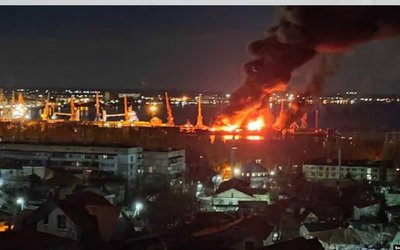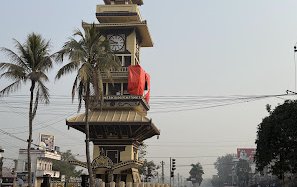
A UK-funded bridge over the Arun River in Eastern Nepal was inaugurated by Khil Raj Regmi, Chairman, Council of Ministers, UK Ambassador Andy Sparkes and Gail Marzetti, Head of the UK’s DFID Nepal.
The bridge built over the Arun River at Leguwa Ghat will safely link thousands of isolated communities in Bhojpur and Khotang Districts in Eastern Nepal for the first time. The bridge, completed and opened to traffic in October 2013, is set to bring an economic boost to families in one of Nepal’s most remote regions. The bridge provides the first year-round crossing of the Arun River at Leguwa Ghat.
The 120m steel truss bridge will connect hundreds of kilometres of strategic and local roads, and provides vital connectivity to the 280km of roads supported by DFID’s ‘Rural Access Programme’. It will ensure the flow of trade and goods to the east of the country, bringing business, tourism and jobs so that the people living around Leguwa Ghat can work themselves out of poverty. The bridge will also save the lives of people paying for the dangerous boat service to cross the raging Arun River during the rainy season. The unique bridge was designed to withstand earthquakes and flash floods.
In his speech in the opening ceremony, Chairman Khil Raj Regmi said, “We want to thank the British government very much for this bridge which is a symbol of the excellent relations between our two countries.”
DFID Nepal Head, Gail Marzetti, said: “This bridge proves how British aid can make a real difference, helping the people of Nepal to lift themselves out of poverty. This bridge is a life-line. It will allow communities to work and trade, send their children to school and access health care.”
UK Ambassador Andy Sparkes commented: “This bridge is a perfect example of the strong partnership between Nepal and the UK. Villagers told me that they were very happy with the bridge. Since it has started to operate they are getting rice much cheaper. This bridge is built to last for over a hundred years and the UK’s special relationship with Nepal is nearly twice that old already.”
A similar bridge was opened in April this year in Sankhuwasabha District, connecting hundreds of kilometres of strategic and local roads, the region’s only all-weather airport and a landmark hydro-electric power. The two bridges will connect 280km of roads already built in the area. This will allow farmers and other traders from four districts in eastern Nepal – Sankhuwasabha, Khotang, Bhojpur and Dhankuta – to reach markets as far away as India. The bridges, part of DFID’s Rural Access Programme, are the final links in a chain to improve access to roads for 900,000 people who previously had to walk for more than four hours. Over the past ten years more than 970km of road have been built by DFID, providing employment for 24,000 poor families.
The DFID Head also commented that: “The next phase of the Rural Access Programme will lift 20,000 people out of poverty and generate 7.5 million days of employment in the western Nepal”.
According to a press release issued by British Embassy, the UK Government provided £3m for the construction of the Arun River bridge. UK will invest £36.5m in the third phase of the Rural Access Programme to maintain, upgrade and build 2,400km of road over the next four years.
- MELAMCHI WATER SUPPLY: No Interruption During Monsoon
- Jun 25, 2025
- KOREAN RETURNEES: Successful Integration
- Jun 25, 2025
- UPPER TRISHULI-1: Engaging With Local
- Jun 25, 2025
- IME GROUP: Twenty Five Years Of Journey
- Jun 24, 2025
- NEPAL’S AIR POLLUTION: A Growing Health Concern
- Jun 24, 2025















